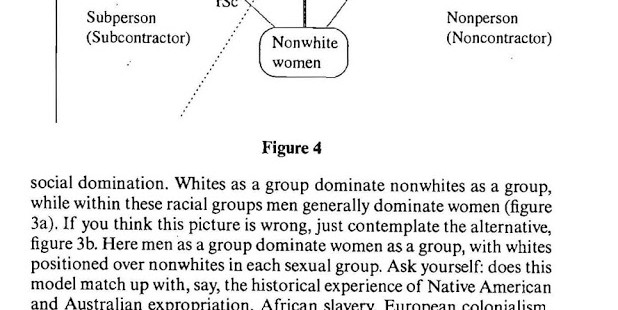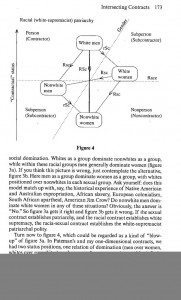
Contract Theory, Intersectionality, Neoliberalism, and Absolute Music
I’m working on a manuscript that, among other things, ties classical liberalism to a specific “aesthetic”—what I call “liberal realism”—and neoliberalism to another sort of aesthetic—what I might call “neoliberal formalism” (I’m not entirely decided on this latter term). While other scholars have made this or similar distinctions, I’m arguing that “liberal realism” is both the product of a centering of the visual in feminist/philosophical analyses, and also reinforces the continued centering of viz-based frameworks. Neoliberal formalism, on the other hand, eschews viz-centric analyses, and is more robustly and accurately captured by sound-centered frameworks.
I want to take some time to flesh out an example we discussed a few weeks ago in my graduate Feminist Theory seminar, because it clearly and effectively connects classical liberalism—in the form of social contract theory—to viz-centrism and realism, and suggests how and why neoliberalism requires different, non-viz-centric, non “realist” interpretive tools.
In his discussion of “intersecting contracts” in Contract & Domination, Charles Mills includes a chart depicting the relative positions of white men, black men, white women, and black women, vis-à-vis one another and, more importantly, to full moral/political “personhood.” This chart has two axes: race is the Y axis, gender the X axis. Mills uses this chart to illustrate his claims about the intersection of the “racial contract” with the “sexual contract” to form what he calls “racial patriarchy.” He’s arguing that racia-sexual contracts create white men as “full persons,” nonwhite men and white women as “subpersons,” and nonwhite women as “non-persons.”
It is interesting that classically liberal social contract theory lends itself so easily to two-dimensional representation on a more-or-less Cartesian grid. Classical liberalism, with its realist focus on identity-content, treats identities as separable variables which can be graphed “intersectionality” in 2D. But what do I mean by this “realist focus on identity-content”? Classical liberalism—the Modern social contract theorists—created“race” and “gender” as social identities. Sexual difference and ethnic/national difference existed in premodern Europe, but the idea of “social identities” is a product of Modernity. Social identities are external, visual representations or signals of internal, invisible, inner “content” (e.g., skin color is a representation of intelligence, just as one’s taste in film can supposedly be inferred from one’s gender). So, social identities assume that there is a “true inner ‘self’” that may (or may not) be accurately expressed by one’s visible appearance. (Though I won’t talk about it much now, it’s here, in this idea of the trueinner self, that the “realism” factors in. Liberalism treats identity as content which we are obligated to authentically represent or express.) This idea of the “true inner ‘self”” is a product of the Enlightenment—in fact, it, too, is Cartesian (Cogito, ergo sum, as they say). So, the conception of race and gender as social identities is a specifically Modern, which is to say, Contract-based, way of handling sexual and ethnic/national “difference.” So it historically/contextually makes sense that this classically liberal social identity models of “difference” lend themselves to representation in Cartesian grid form. In fact, this Cartesian grid is, more or less, the “traffic intersection” in Kimberle Crenshaw’s theorization of intersectionality: the X and Y axes “intersect” like roads. As Jasbir Puar argues in her “I”d Rather be a Cyborg than a Goddess” essay, “intersectionality” is a classically liberal discourse that treats “intersecting” identities as “matter that functions…through signification” (8). I’m arguing that there is also a fundamental conceptuallink among classically liberal social identity and the 2D Cartesian grid. Race and gender, as social identities, are contents which can be isolated as variables in an equation, and then re-presented on a 2D Cartesian grid.
However, as my students pointed out, if you try to introduce another variable—like class, or sexuality, or immigration status, this graph collapses, breaks down, and fails. Perhaps one could introduce a Z axis, but we’d need at least two more axes to include the few extra variables I’ve just mentioned. And the underlying problem can’t be solved by increasing the number of axes/variables, because treating race and gender as “identities” that can be translated into isolatable “variables” is itself the problem. Especially in neoliberalism, race and gender aren’t identities but technologies—i.e., if they’re not represented content, but relational processes. As Puar explains, in neoliberalism, “the focus [is] not on content but on relations, relations of patterns…specific connections with other concepts is precisely what gives concepts their meaning” (4). Cartesian coordinate systems can’t adequately describe or capture these neoliberal formal processes. Put differently, neoliberalism treats race and gender as technologies, as a how, but the classically liberal social identity treats them as a what. The 2D Cartesian grid can represent the what, but not the how, the content but not the patterns of relations.
We need different metaphors, different discourses, different forms of notation, to describe this “process” or “technological” aspect of race, gender, sexuality, etc. Word clouds are a good, if still “visual” example here: they show the relations among word frequency in a passage of text; they do not indicate words’ meaningful/signified content (if only for the fact that there is no grammar or syntax).
Music (by which I mean Western art and popular musics, and sometimes sound art) doesn’t and generally never has been a medium focused on signified/represented “content;” listening to music involves paying attention to relationships among events, it involves pattern recognition. (Obviously I’m bracketing lyrics here—I would go so far as to argue that lyrics, insofar as they function verbally as signifiers of signified content, aren’t really “music” at all.) In the manuscript I develop a number of ways that musical works, concepts, and practices are productive resources for theorizing both neoliberalism itself, and strategies to subvert/resist/critique it. For example, one thing I’ve been thinking about today is the discourse of absolute music. This is really rough, and I haven’t at all thought through it in any detail, and could probably really use y’all’s help here. BUT, I think the discourse of “absolute music” might be an early, 18th/19th c manifestation of some of the concepts, structures, and values we now associate with neoliberalism. “Absolute music” is music without words or programmatic content—instrumental music (usually) that “is about” music itself. (In this way, Western art music was Greenbergian-modern (as distinguished from Cartesian-Modern) in the 19thcentury: music was “about” the formal properties of its medium.) In absolute music, there is no expressive “subject,” no represented content—just formal relations. Meaning was crafted through formal relations—e.g., Haydn’s “Surprise Symphony” built the eponymous “surprise” from relations among “dynamics” (what non-musicians might call “volume,” or loudness and softness). Tonal harmony is classically liberal, but the discourse of “absolute music” approached neoliberalism, even if pieces of symphonic/absolute music were tonal.
It’s worth noting that the discourse of absolute music rose to philosophical/musicological prominence in, for example, Hanslick’s work at that same point in the 19th century that “the biopolitics of the population” came to prominence, in, for example, the equally new discourse of sexuality.
Ultimately, I’m not sure yet if this neoliberalism:absolute music comparison holds—I need to do the research. But I suspect it might. And I suspect it might tell us something interesting about biopolitical/neoliberal technologies of race, gender, and sexuality.

Extraordinary work you metal band t-shirts folks are doing with this webpage.